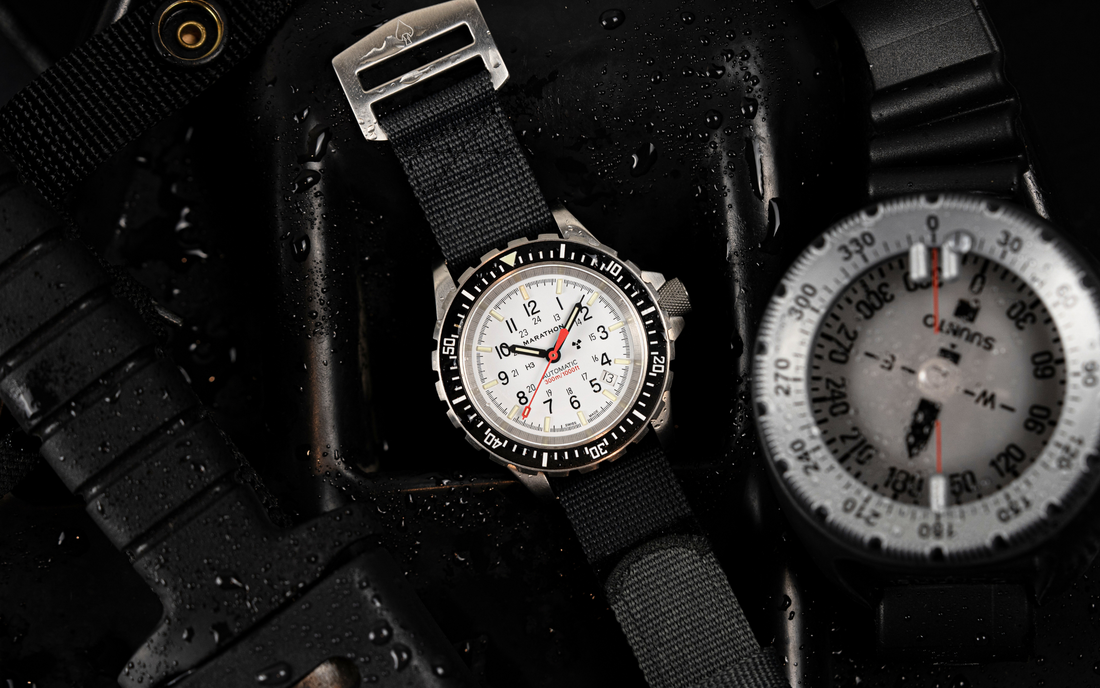Putting One Of The Last Real Military Dive Watches To The Test
In the watch world, clout is king. For brands without centuries of history to lean on, sales and marketing professionals are left in a mad scramble for authenticity and heritage, searching for a story that makes their watches more than the sum of their parts. These efforts become particularly transparent when those outside our community attempt to influence those within, claiming their mechanical luxury watches are the preferred option for divers, SpecOps, or intelligence professionals.

The Marathon SAR was unveiled in 2001. (Photo Credit: Worn and Wound)
In reality, Digital Tool Watches (D.T.W.) are most often the instrument of choice, but there is at least one analog tool watch still issued to the US Military in 2024: Marathon Watch. This isn’t the first time we’ve covered Marathon, a supplier to the US and Canadian governments since the Second World War. However, in this Dispatch, we’ll concentrate on the Search and Rescue (SAR) collection in particular, sharing its bizarre history and modern military associations before testing the watches on a dive on the California coast.
It’s also a family of watches with which I have a significant history, having used both the quartz and automatic variants while serving the US Coast Guard and as a commercial diver. Beyond the utility, the Marathon SAR also has one of the more unusual origin stories in modern watchmaking.
Watch Nerds Designing A Military Tool Watch For Operators

RCAF SAR Techs made the initial request that led to the Marathon SAR Collection. (Photo Credit: Canadian Armed Forces)
In 2000, Marathon Watch was approached by the Canadian Armed Forces (CAF) with a request for a purpose-built dive watch capable of handling the wide range of environments encountered by Royal Canadian Air Force (RCAF) Search and Rescue Technicians or SAR Techs. Trained in “...Arctic rescue, parachuting, diving, mountain climbing, and helicopter rescue”, the elite community of around 150 SAR Techs had a few specific requests including luminescent indices for legibility in all conditions, an automatic caliber, ample water resistance, and a bezel that could be easily operated with all manner of gloves.
In designing the watch, Marathon did something all but unheard of, looking to members of the watch enthusiast community for guidance. Marathon first tapped one of its military suppliers who then got in touch with the founder of the Military Watch Resource (MWR), a niche online forum dedicated to military horology. With the help of a talented machinist, the first SAR watches came together, with input being gathered at each stage of the design process from members of the MWR forum who also coined the SAR name.

The original Marathon SAR of 2001 utilized printed luminescent indices while being inspired by several great historical dive watches. (Photo Credit: Worn & Wound)
With a 39mm case silhouette generally inspired by the Rolex Submariner, a dial format resembling the Benrus Type I, a distinctive knurled crown, and an overhanging 41mm bezel reminiscent of a rare East German military diver’s watch from a brand called Ruhla, Marathon delivered the first orders of its new SAR watch in late 2001.
Initially, the Marathon SAR was only available through official supply channels and in limited numbers, with a few select enthusiasts getting their hands on rare contract overrun pieces. Issued not only to SAR Techs but also Clearance Divers and other amphibious members of the Canadian Forces since 2001, an important design change to a tritium gas tube illuminated dial around 2005 answered a specific request from the US Military.
While they are not widely issued, the GSAR or Government Search and Rescue as it is now known, and its quartz equivalent the TSAR or Tritium Search and Rescue, can both be ordered by military procurement specialists in the United States through the GSA catalog — a sort of military and government Amazon — using unit-allocated funds.

USAF Pararescuemen wearing the Marathon GSAR while conducting dive training in 2019. (Photo Credit: DVIDS)
Issued Marathon watches are not ubiquitous by any means, but it does happen. According to Marathon’s Government Contracting Officer, US Navy EOD, US Air Force Pararescue, and US Army Special Forces have all recently placed orders for watches from the SAR family. Our previous look at Marathon detailed several additional issued examples of the GSAR and TSAR. I distinctly remember seeing issued Marathon watches on the wrists of USCG Divers and select Aviators in my Coast Guard days.
Over the years, Marathon has adjusted its approach to include a broader offering of watches intended for the civilian market while still doing the vast majority of its business for government contracts.
Diving With The Modern Marathon SAR Collection

(Photo Credit: Worn & Wound)
The SAR collection has grown by leaps and bounds since its humble beginnings in the early 2000s. There are three case sizes (36mm, 41mm, and 46mm), quartz and automatic options, an automatic chronograph, and several dial colors and configurations. Marathon has leaned into the rise of watch enthusiasm but without losing the core direction. To obtain feedback from end-users and get closer to the enthusiast community, Marathon invited a few interesting individuals from the military and diving communities for a dive preceding Windup San Francisco, an enthusiast-oriented event.

In 55-degree water, you wear as much rubber as you can. (Photo Credit: Worn & Wound)
Preparing for a shore dive in water around 55°F/13°C, most of us donned thick 7mm wetsuits with a few ziploc bag enthusiasts opting for drysuits. Once suited up, we had our pick from a slew of Marathon SAR watches including the white Arctic dial GSAR, a JDD or Jumbo Day/Date, and an Anthracite GSAR. I used an original SAR from the printed MaraGlo dial days. Discontinued in 2006, the OG Marathon SAR is, according to a source within the company, poised for a triumphant return later this year bolstered by some subtle updates. A few of us needed to swap over to nylon straps to get our watches over our variety of thick exposure suits, but we were soon ready to go.

Petty Officer Second Class (ND2) Brock Stevens with a Marathon Arctic GSAR. (Photo Credit: Worn & Wound)
My buddy for the dive was Navy Diver Second Class (ND2) Brock Stevens, a veteran of over four years of ships husbandry on carriers and nuclear submarines in Norfolk, Virginia. Typically diving with a Kirby Morgan helmet as opposed to open circuit scuba, Brock is a guy with well over a thousand dives and is at home in the water. After the walk from the parking lot to the beach with all of our gear, we put on our fins and waded into deeper water.
California diving can be hit-and-miss. In Monterey, being cold is all but assured, but the visibility varies wildly from as much as fifty feet or more on the best days to the three to five feet we had for our dive. That said, as you’d expect, everyone’s Marathon watch worked as intended, each of us timing the dive with our rotating bezels which remained legible even in murkier conditions. I had a diving computer on my other wrist, but given our max depth of around 40 feet, we would run out of gas long before any decompression-related concerns, and I could have easily left it on the beach.

The visibility left something to be desired. (Photo Credit: Brock Stevens)
After descending, we finned along a submerged outfall pipe covered in growth with the odd clump of kelp running lazily from the sea bed to the surface. Given the visibility, I kept Brock just within the limits of my range of vision. Reaching the end of the pipe, we set out for a field of metridiums, an out-of-this-world underwater forest of what looked like giant cauliflower stalks, then returned to the pipe for a leisurely swim back toward the shore.
A dive like this goes nowhere near the limits of these watches, which are designed for and capable of much harder use. Brock has been using his Marathon while working on submarines, and it seems to be holding up. Still, it’s nice to see a brand invite a bunch of actual divers to experience their tools in their element. Given the SAR collections’s history, we know Marathon is no stranger to taking feedback from the enthusiast community, with a slew of recent releases to support the trend. When we met with the brand after the dive, they seemed genuinely interested in our feedback, which is seldom the case with watch brands.

Brock Stevens wearing his Marathon GSAR while working as a US Navy Diver. (Photo Credit: Brock Stevens)
My positive experiences with the watches aside, I would argue the modern GSAR isn’t for everyone. It’s not refined or elegant, it's a tool. Given the tall bezel, it fits poorly under shirt cuffs. But the GSAR isn’t about that. It’s a watch that was designed as a tool. While it’s true most people don’t use dive watches as the tools they once were, some still do. The entire concept of being “mil-spec” or military issue adds credibility to any piece of equipment and in the arena of dive watches in particular, Marathon’s legitimacy as a diving tool is well deserved.
If you enjoyed this article, please consider signing up for our weekly free newsletter for further updates HERE.
About The Author: Benjamin Lowry is a US Coast Guard veteran and commercial diver turned watch writer. Now a full-time member of the W.O.E. Team, Ben splits his time between writing and product development at W.O.E. and managing Submersible Wrist, a watch spotting account dedicated to military and commercial divers as well as the life aquatic.
Thanks again to Brock Stevens for providing several of the images in this Dispatch. To learn more about Brock, check out @deepsea.edc on Instagram.
READ NEXT: Watches and Commercial Espionage: Waltham Watch Company









21 comments
I got to see the development of the watch first hand, as I was a ‘Lurker’ on MWR before I ‘became’ a member. Back then, the tongue-in-cheek soft marketing (there was none) was Submariner :: Jewelry Watch, SAR :: Tool Watch. We didn’t think twice about modifying SARs to our liking, before they became more collectible. Look out on the interwebs for crazy SAR configurations, they are out there. The SAR was the Paradigm shift for the Modern Dive watch; the watch industry noticed, and upped their game. Also, the Microbrand industry was spawned by the SAR. Thanks, WOE.
Excellent work guys
Great to read about the Marathon SAR series on WOE. One correction- the switch to tritium happened not in 2006, but at least as early as March 2005. That’s how my TSAR case back is stamped and I bought it in July 2005. It’s been around the world with me a few times since.
I had to replace the quartz movement last year which Marathon was unable or unwilling to do. Fortunately Wilson Watch Works was able to help me and I’m very pleased to have my old TSAR back at work. In addition to servicing, they have new and custom Marathons for sale on their site. Highly recommended!
I’ve had my TSAR since 2006, purchased privately (through CountyComm, IIRC) while on an Army SF Dive Team. It’s been to hell and back but remains on my wrist to this day. Only had to replace the batteries and wristbands to date.
Awesome write up! Awesome shots! Awesome watch! Just picked up a GSAR myself and am excited to pack some adventures into it